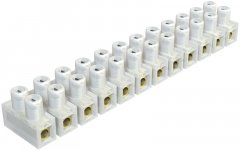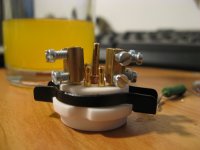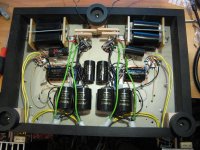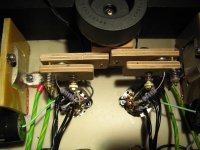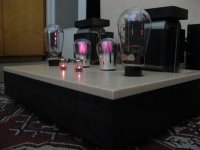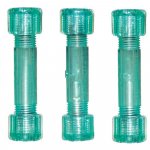Before two years I made an amplifier without soldering in signal path, just in some places, where I wasn't able to avoid them. Last month I upgraded it... for this two years was working without any problems. There wasn't any loose connections, or something that shows that there will be future problem.
Connections was made with connectors like this, I don't know their English name:
http://www.diyaudio.com/forums/attachment.php?attachmentid=604976&stc=1&d=1489357376
First try was with the original iron screws. Now I put also brass screws, like the material of the connector.
The reason was that before few years I made few same E88CC preamps, each soldered with different soldering wire... all was sounding different. Then tried solderless... it was also very different, but very smooth and clear tone, much more natural than others. The best sounding soldering wire was lead-free Furutech... can't remember the exact model. After that I made the first amplifier in that way...
Maybe many of you have tried it on interconnects - soldering vs screw connection? All that I have read before is, that the screw connection has better sonic quality than soldering connection.
For sure, it can't be such reliable as soldering connection, but for me, the gain in the sonic quality is enough big to do it so.
I will be happy if someone else have also tried it, or try it and share his experience.
Regards.
Connections was made with connectors like this, I don't know their English name:
http://www.diyaudio.com/forums/attachment.php?attachmentid=604976&stc=1&d=1489357376
First try was with the original iron screws. Now I put also brass screws, like the material of the connector.
The reason was that before few years I made few same E88CC preamps, each soldered with different soldering wire... all was sounding different. Then tried solderless... it was also very different, but very smooth and clear tone, much more natural than others. The best sounding soldering wire was lead-free Furutech... can't remember the exact model. After that I made the first amplifier in that way...
Maybe many of you have tried it on interconnects - soldering vs screw connection? All that I have read before is, that the screw connection has better sonic quality than soldering connection.
For sure, it can't be such reliable as soldering connection, but for me, the gain in the sonic quality is enough big to do it so.
I will be happy if someone else have also tried it, or try it and share his experience.
Regards.
Attachments
Almost like wire-wrap:
https://www.tubesandmore.com/products/socket-8-pin-octal-78-fits-1-hole-bracket-pc-mount
With those solderless connections, you will need to scrape the lead/tin off all the component leads too.
And have you de-magnetized all the steel and nickel (tube) parts also?
You will also need a nitrogen atmospheric containment to prevent oxidation of surfaces.
And any temperature variations throughout the circuitry will induce thermo-electric junction potential offsets. So maybe immerse everything in liquid Freon. Tubes should be shielded from any light to prevent internal photo-electric emission effects. Then there are those micro-phonic effects on the tube elements too. Encase everything in foam rubber.
https://www.tubesandmore.com/products/socket-8-pin-octal-78-fits-1-hole-bracket-pc-mount
With those solderless connections, you will need to scrape the lead/tin off all the component leads too.
And have you de-magnetized all the steel and nickel (tube) parts also?
You will also need a nitrogen atmospheric containment to prevent oxidation of surfaces.
And any temperature variations throughout the circuitry will induce thermo-electric junction potential offsets. So maybe immerse everything in liquid Freon. Tubes should be shielded from any light to prevent internal photo-electric emission effects. Then there are those micro-phonic effects on the tube elements too. Encase everything in foam rubber.
Last edited:
I think from an electrical perspective a solder joint is greatly preferable to relying on a mechanical connection between a bunch of dissimilar metals. This should be fine for prototyping and short term use but longer term electrolysis and corrosion will be a problem. They also seem to sometimes loosen up.
Almost like wire-wrap:
https://www.tubesandmore.com/products/socket-8-pin-octal-78-fits-1-hole-bracket-pc-mount
With those solderless connections, you will need to scrape the lead/tin off all the component leads too.
And have you de-magnetized all the steel and nickel (tube) parts also?
You will also need a nitrogen atmospheric containment to prevent oxidation of surfaces.
And any temperature variations throughout the circuitry will induce thermo-electric junction potential offsets. So maybe immerse everything in liquid Freon. Tubes should be shielded from any light to prevent internal photo-electric emission effects. Then there are those micro-phonic effects on the tube elements too. Encase everything in foam rubber.
wire-wrap IS a welding process where the metals makes a gas-tight connection, safe for oxidation, safe for moisture. In addition it is fault-proof, where soldering depends on skill and proper working. Just read about "cold joints"
or failed solders that comes in almost every other thread here.
Wire-wrap is a technology that suits very well for inexperienced person
working ad-hoc.
Wire-wrap technology have few limits to be usable... I can't give you exact numbers (you can find it with google), but:
1. the core (where you wrap the wires) always have to be with square profile;
2. the wire can't be with greater diameter than the core, also can't be much smaller;
3. you can wrap wires only on the core;
4. the core and the wire have to be from the same material (maybe gold plated core will be OK with all materials), if the materials are different - tinned or nickel plated core with copper wire... soon or later they will make corrosion.
You can find many images of old wire wrapped devices... you will see that all the points are performed.
When wrapping the wire on the core, it creates tension and the wire bents the core. That makes the connection very tight and reliable. I have never seen loosen wire wrap connection... when all the points above are fulfilled. But they all creates only limitations of the technology and it have very limited range of use...
In the amplifier from the first post I have used brass joints with brass screws and copper wires - they are OK for that.
1. the core (where you wrap the wires) always have to be with square profile;
2. the wire can't be with greater diameter than the core, also can't be much smaller;
3. you can wrap wires only on the core;
4. the core and the wire have to be from the same material (maybe gold plated core will be OK with all materials), if the materials are different - tinned or nickel plated core with copper wire... soon or later they will make corrosion.
You can find many images of old wire wrapped devices... you will see that all the points are performed.
When wrapping the wire on the core, it creates tension and the wire bents the core. That makes the connection very tight and reliable. I have never seen loosen wire wrap connection... when all the points above are fulfilled. But they all creates only limitations of the technology and it have very limited range of use...
In the amplifier from the first post I have used brass joints with brass screws and copper wires - they are OK for that.
The connectors shown in post 1 are known (unofficially) in the UK as 'chocolate block connectors'. I suspect this is partly due to their shape, but more because originally they were made from dark brown Bakelite.
My own view is that this is a good way to rig up an experiment, but a bad way to make a piece of equipment for regular use. I ignore any claims about sound quality; even if true (which I doubt) what is the point of an excellent sounding piece of equipment which needs frequent repairs due to poor connections breaking things?
My own view is that this is a good way to rig up an experiment, but a bad way to make a piece of equipment for regular use. I ignore any claims about sound quality; even if true (which I doubt) what is the point of an excellent sounding piece of equipment which needs frequent repairs due to poor connections breaking things?
Hmmm... So just twist or wire-wrap, and apply Epoxy.
Whoa...Even better... Immerse each well cleaned wire or terminal contact in Mercury to wet its surface first. Then, twist or wire-wrap the connections and dip in Epoxy as a seal. Try and sell that in the EU!
Yeah, now I remember submersible well-pump wire contact joints. Insulating tubes with compression seals for the wires at each end. These should hold the Mercury vapor in for 20 years hopefully.
Whoa...Even better... Immerse each well cleaned wire or terminal contact in Mercury to wet its surface first. Then, twist or wire-wrap the connections and dip in Epoxy as a seal. Try and sell that in the EU!
Yeah, now I remember submersible well-pump wire contact joints. Insulating tubes with compression seals for the wires at each end. These should hold the Mercury vapor in for 20 years hopefully.
Attachments
Last edited:
The first part of that statement is absolutely correct. The second part is complete dingo's kidneys.I remember reading somewhere recently by a very well respected audio bod ( I will try to find quote ) that the ideal electrical joint should first have mechanical integrity then be soldered, the solder's primary function being to preserve the mechanical connection.
But did they do any blind AB listening tests comparing against solder joints?Screw contacts were not unusual in radios from the 1920's, as far as I know.
What....it's correct that I read it somewhere?
Maybe we could debate that.
Sent from my phone with Tapatalk. Please excuse any typpos.
I remember reading somewhere recently by a very well respected audio bod ( I will try to find quote ) that the ideal electrical joint should first have mechanical integrity then be soldered, the solder's primary function being to preserve the mechanical connection.
This is what they use to teach you in the Swedish army if you where a technician
The solder is not intended to be a conductor, it's a mechanical thing - if done right. Best practise!
Edit: and it's not glue so you better mount/wire the things to be connected in a way that they can take some force - it should work without solder and withistand some mechanical offence... then solder.
//
Last edited:
- Status
- This old topic is closed. If you want to reopen this topic, contact a moderator using the "Report Post" button.
- Home
- Amplifiers
- Tubes / Valves
- solderless amplifier?
